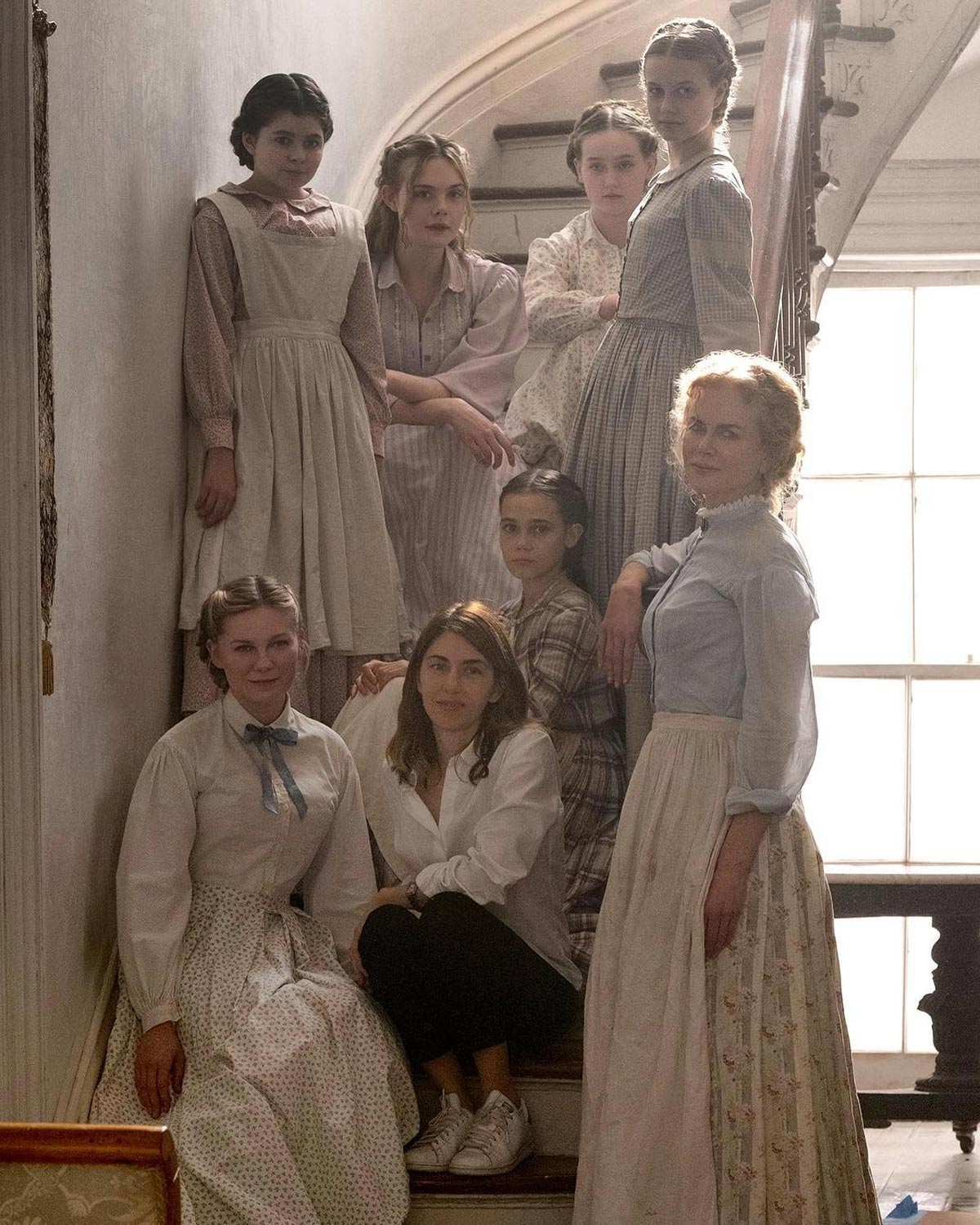“I found him in the woods. Miss Harriet had given me permission to hunt for mushrooms as long as I promised not to go beyond the old Indian trail, which is just before the woods begin to slope down to the creek. Well all that land belongs to the Farnsworths but they never have used it for anything, I guess, which is fine with me. I prefer to have places like the woods kept just the way they are. Anyway, on that afternoon – during the first week of May it was – I didn’t find very many mushrooms, but I did find him.” – Thomas Cullinan, The Beguiled
[please note that this article may contain spoilers]
At the beginning of Sofia Coppola’s The Beguiled, a girl picks mushrooms in the woods, happily humming to herself, grabbing the curious little fungi that peek out at you from above ground. Mushrooms are strange creations in nature – pretty and fleshy and always unique, they seem to just sit there innocently after they burst forth from the earth – but if you pick the wrong one (or the right one, depending on your intent) and eat the little thing, you could fall down a psychedelic rabbit hole filled with pleasurably mind expanding or terrifying (or both) sensations. Or, you could die. Their potential toxicity makes mushrooms a bit exciting and even dangerously alluring since, if you were of the mind to do so, you could use those strangely shaped buttons to deceive a person. Or mess with their life. Eat this side of the mushroom to grow larger, or the other side to grow smaller, says the caterpillar to Alice. While collecting the delectables, she stumbles across a mysterious man, and one who is deemed the enemy, all bloody and wounded and dirty, almost entangled with the trees and bramble and soil. It’s a beautifully poetic moment – simultaneously ominous and fairy-tale-like – and Coppola shoots it with a kind of intoxicating, frightening excitement. You needn’t know anything of this girl or her secluded life among only woman to feel the particular power of this scene. This is not just a man, this is an upset to order, positive or negative. Nature, sex, morality – it can be unruly and tough to untangle, no matter how hard you try to control it in yourself or others. And love? Good luck. As Katherine Mansfield wrote: “If only one could tell true love from false love as one can tell mushrooms from toadstools.”
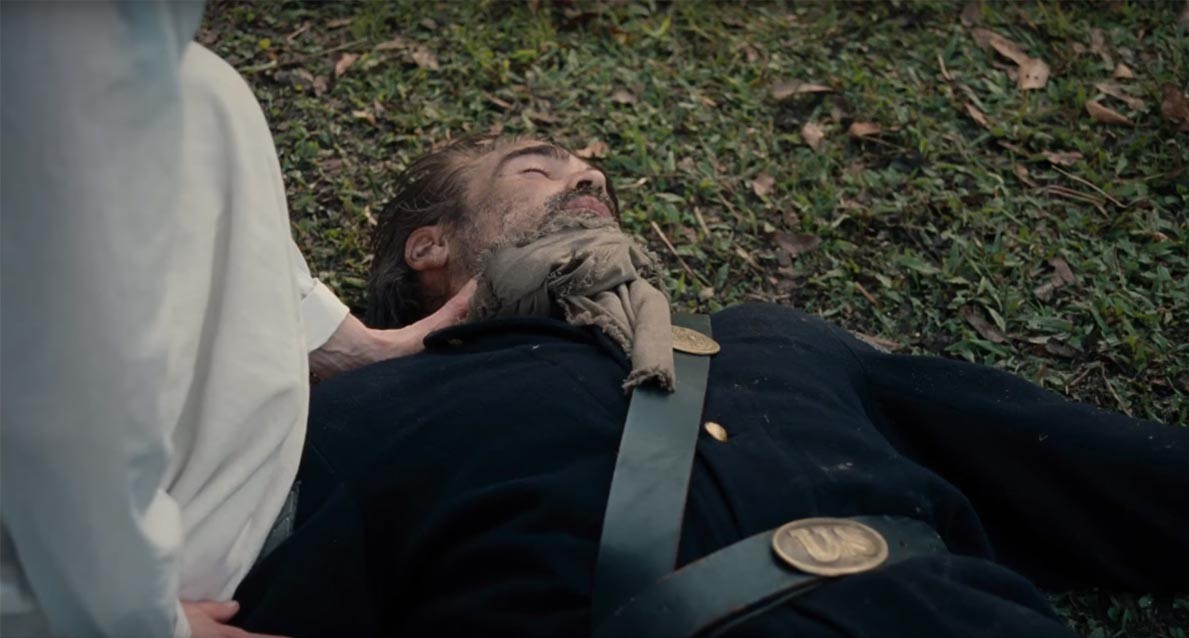
The time is during the thick of the American Civil War, and the place is rural Virginia, dangerous territory for the man who is near-death, deeply wounded – Union Army Corporal John McBurney (Colin Farrell). This man has deserted the battlefield (and admits it later, knowing he’ll be perceived a coward, but honesty seems a clever calculation), after he sold himself to the Army (and for $300). Selling himself more than suggests this man has done quite a few things to simply survive, and in that way, he’s sympathetic. But no one is so easy to read in Coppola’s hypnotic, eerie, at times swooningly erotic Southern gothic, an adaptation of Thomas Cullinan 1966 novel (first made into the excellent 1971 Don Siegel picture starring Clint Eastwood and Geraldine Page). Wisely, and refreshingly, Coppola allows us to decipher how we feel about these people with mood, style, stolen glances, and movement, often very slow – even open wounds are something to ponder as they’re sewn up and busted open (like bodices), as is the melodrama that is, in brief, stark moments, vociferous and at other times, quiet and gorgeously muted. It’s a brilliant fever dream in Coppola’s hands – rooted in the messy emotions of desire, the interpersonal games we play, our longing for at least a break from loneliness and fear, and not necessarily through physical independence, but for a kind of psychic freedom.
Wonder and fear begin the picture – as McBurney is begging for help, and from a little girl one would think is merely skipping through the forest. She’s an easy target and his only hope. But don’t underestimate little girls who pick mushrooms. That girl is ever-curious pre-teen Amy (Oona Lawrence), who, after her initial shock, empathizes with the bleeding man and assists the soldier, no matter what side he is on (a “blue belly”), nearly dragging him with all of her little girl strength back to where she lives – The Miss Martha Farnsworth Seminary for Young Ladies. The house is a large, rambling plantation with white columns and overgrown foliage, a place once stately but still beautiful – like the man, it seems to be intertwining with nature. There are no men and their female slave who had once lived there has taken off as well. These are women and girls alone, cloistered, even, with their own unique personalities and opinions of one another, not all good. They’re trapped, but they’re also self-sufficient, and all seven of them help each other to keep up the grounds as best as they can, cook, do laundry, while continuing their schooling (only inside the house), conduct music recitals and lessons in good Southern manners. You can feel the war raging around their shaky sanctuary – canon fire can be heard in the distance so much that it sounds as expected as the weather. It also punctuates the powder keg of emotions these women have been stifling inside of themselves.
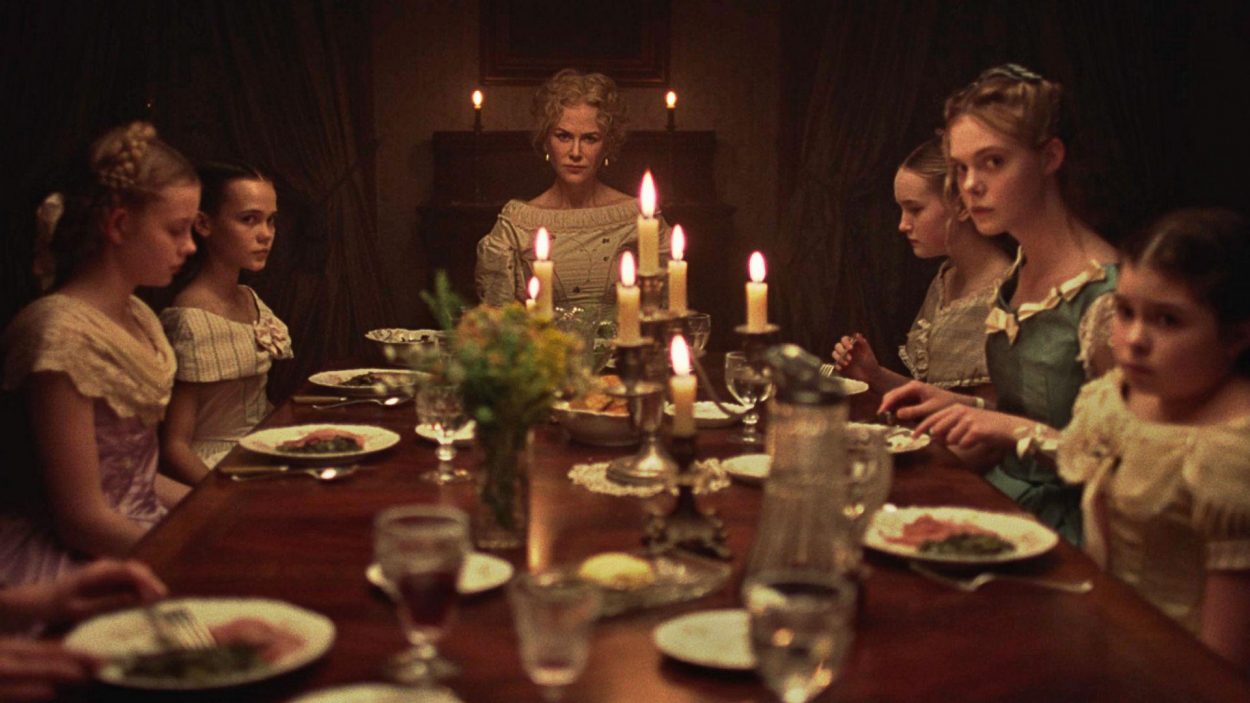
With the approval of the strict, intelligent and subtly scary matriarch (scary, so far, in that she is the one who wields all of the power), Miss Martha Farnsworth (Nicole Kidman), McBurney is dragged in and tended to. His arrival is reasoned as the good Christian thing to do, but we already sense other motivations, one being the curiosity and excitement of this exceedingly handsome, clearly charismatic intruder/guest. Martha sews his wound (it’s a strangely lovely scene – matter of fact more than maternal) and in one of the film’s most erotic moments, she carefully bathes him while he lies in bed at her mercy. Watching Martha rub down his chest and nearing his pelvis, her usual flintiness now clouded with allowed intimacy and the thrilling act of looking at this man’s body (something she’s not done in quite some time) is intriguing – Kidman’s inner emotions are not only sexy but oddly tense and fascinating to observe. They’re even a little sad. She must repress.
When McBurney is more ambulatory and able to talk (and flirt, Farrell does so with charm and sensitivity, it’s easy to see why the women take a shine), he’s clearly caught the idea that manipulation will keep him alive. It’s not predatory, necessarily; after all he’s helpless to his injury and to the fact that he could be turned over to confederate soldiers. He works Amy as the one he likes best (she saved him, so why wouldn’t she believe it? And why wouldn’t we for that matter?) but sets his adoring (or manipulative) eyes on Edwina (Kirsten Dunst), the teacher whom he sizes up as different (this pleases her – everyone wants to be the special one). Edwina is a delicate beauty but her vague desolation and lonesomeness seem to have made her sag a bit, like she’s slumping through this stifling mansion one day after the other, life is just passing her by. Dunst portrays this with a complicated mixture of world-weariness (of a world she misses) and dreamy ennui. But McBurney’s attention makes her sparkle, causes her to dress a little prettier, wear certain pieces of jewelry and think about attraction – and those around her start to notice. But then, all of the females have been energized by the visitor and start to adorn themselves, pay him room visits and flirt, chiefly Elle Fanning’s teenage Alicia, whom some could consider a tempestuous brat, but … have you ever been a bored, teenage girl? She’s curious and basking in her youthful force because, that’s what living and learning is about. Many girls would act just as she does. And many can be really powerfully good at it.
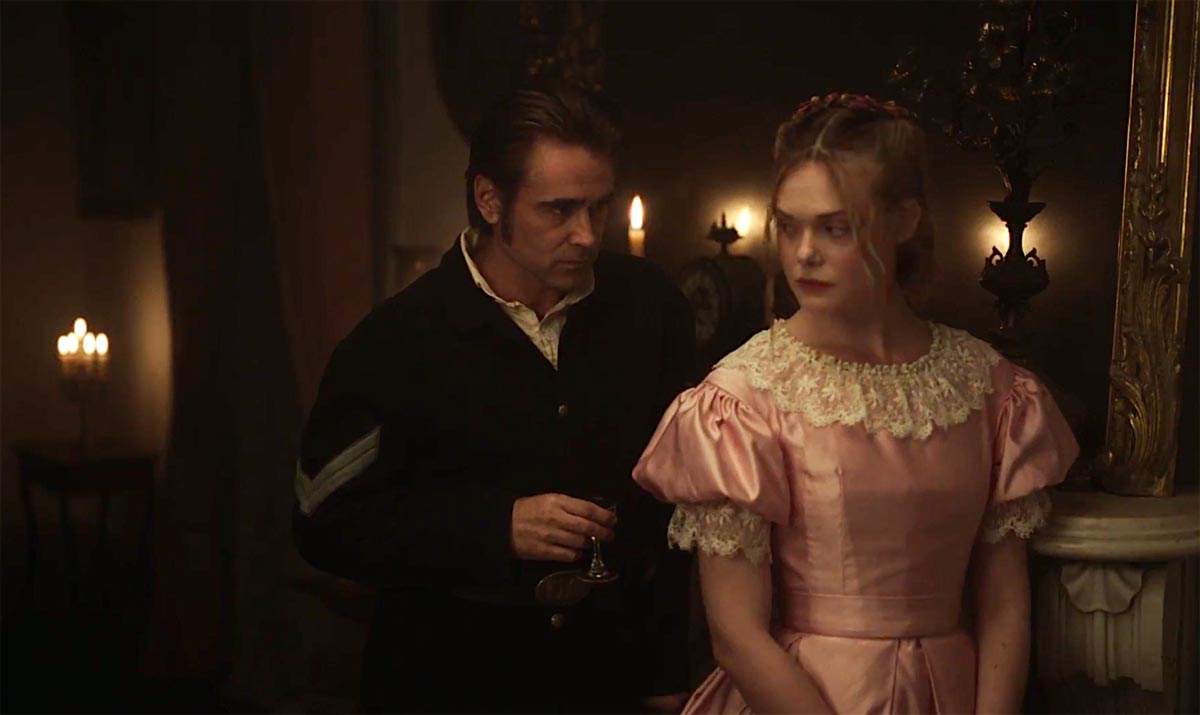
Once McBurney is sitting at candlelight dinners with the females dressed so fetchingly, watching their recitals and with his leg healing nicely, helping out on the grounds, the women begin to compete more openly (there’s a humorous scene about all of those involved with the creation of a pie he likes – and making sure McBurney knows who contributed what to that pie). Farrell sits pleased as the charming, delighted wolf – he knows he’s got them under his spell – and is able to start playing them. This is also when things begin to get extra-thorny and sinister, for all involved. Shot with a gossamer beauty (by Philippe Le Sourd), where warm, candlelit interiors are picturesque and slightly scary; where the outside world has a smoky, gauzy pastoral beauty but feels dangerous (it is dangerous), The Beguiled is positioned inside an alternate universe that’s not too far removed from the reality of the time. From the women’s dresses, to the moss on the trees, to Farrell’s wounds, these are photographed with totemic import – these things mean something to all involved.
And Coppola never heightens any of this meaning or drama toward the ridiculous, even as disastrous and spectacular as it all gets: lust and spurned lust causing a push-down-the-staircase rage, literal, re-opened wounds (this is not a movie about healing), and then, a loss of something quite important to a man (or anyone, but it seems more symbolic here, in understatement), with Martha demanding, “Bring me the anatomy book!” I loved the slow burn of the picture how, even with characters acting with such dubious intent, Coppola refuses to simply demonize either side of the gender divide. When McBurney professes his love to Edwina, you feel the danger in this statement, and worry for her, but you are just waiting for this outburst of passion. God, even if it’s a lie. Let Edwina feel something. And Farrell is so compelling, so convincing, you believe it, for a moment, and you don’t fault him for such machinations. He’s got to save himself too, and he’s using his masculine wiles the way femme fatales stereotypically do. Coppola positions the movie from the female’s point of view, yes, but it’s inherently humanistic and emotionally honest. It’s also droll and witty. She’s not afraid to be funny and recognize the humor of this predicament, and how awful we all can be. We recognize how far some will go, men and women, within this trapped, highly symbolic milieu. The Beguiled isn’t really asking us to take sides – it’s allowing us to figure that out for ourselves – or take no sides. Why do sides need to be taken?
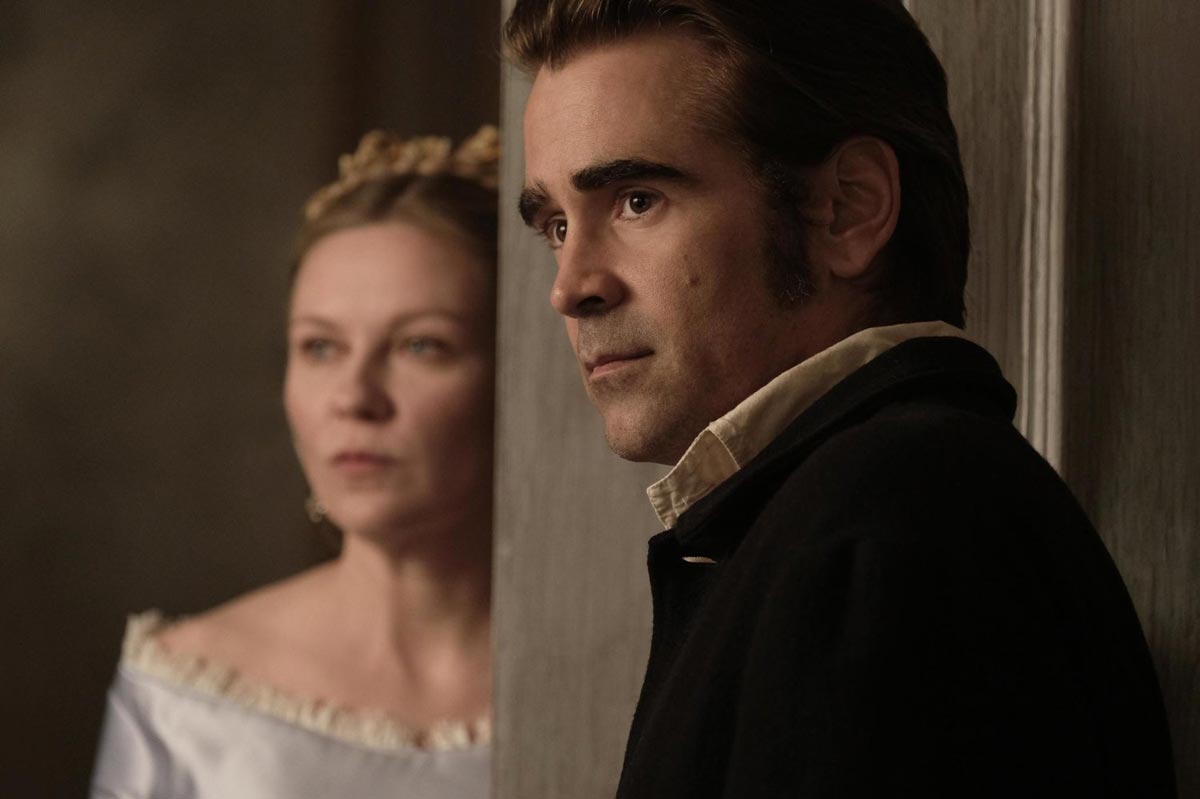
Returning to the fairy tale aspect of Beguiled, I feel this in all of Coppola’s superb, stunning pictures, distinctly her own – the fracture and heart of the fairy tale (The Virgin Suicides and Marie Antoinette especially, but even the castle of the Chateau Marmont in Somewhere or the kids breaking into the fantasy life they’re not a part of in The Bling Ring). Like many girls (and boys), when I read fairy tales, particularly about princesses, I didn’t really think too long about the happy endings (unless they were weird and complicated, like when you read the real Brother’s Grimm) or the morals of the stories – I was instead intrigued by their ideas and images, often of isolation and imprisonment: a woman put to sleep in a glass casket for being too fair, or Rapunzel shuttered away in a tower. These locked-up woman who terrify, yes, jealous women, but more than that, they terrify because they possess a kind of dominance that must be stopped (Maid Maleen is another example – she was locked away for disobeying her father, shades of The Virgin Suicides). When I re-read these stories as an adult, I think of how much these themes permeate the real lives of women. I think, in more current examples, of brilliant women who lived creative, later secluded existences, far too close to their mothers – elusive Dare Wright, Big Edie and Little Edie Beale. They are fascinating and full of questions. Who can blame them for being either scared of the outside world or wanting, really, nothing to do with it (and we don’t really don’t know what they wanted)? Dare Wright worked through her obsessions via ingenious pictures of dolls and bears. The Beales became mythic.
The women of The Beguiled feel mythic too. They may be bored and stifled in that house, but will they ever leave? They certainly adored men, and fell in love with men, but even as they desire, and in the case of Edwina, desire to run away, it’s not surprising they should feel, at first, fear, and then such extreme betrayal and distrust of a man – and finally decree revenge. If they’ve internalized society’s (and particularly during this time period) moralizing of the sexual female, that’s terribly sad, but the ending, both horrific and tragic, is simultaneously haunting and darkly droll. Coppola’s last shot is a twisting of the fairy tale heroine; only, it’s a man, wrapped and supine. There will be no princess to kiss him awake.
